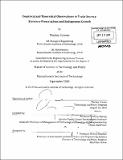Empirical and theoretical observations in trade secrecy : statutory prescriptions and endogenous growth
Author(s)
Craven, Mackey
DownloadFull printable version (7.427Mb)
Other Contributors
Technology and Policy Program.
Advisor
Fiona E. Murray.
Terms of use
Metadata
Show full item recordAbstract
Recent scholarship has suggested that trade secrecy may be as important, if not more important, than patenting as an intellectual property protection mechanism in the United States economy. While patent protection has always been an institution in the United States as a result of its inclusion in the Constitution, trade secret protection has only been statutorily recognized by the federal government in the last half-century. Similarly, while there has been extensive theoretical and empirical research on the incentives patent protection creates for firms to innovate, and the resulting effects on economic growth, there have been comparatively few theoretical studies and only a handful of empirical papers investigating the effects of trade secrecy. This leaves policy makers with little to no understanding of the effects of trade secrecy on the economy or how to influence trade secrecy through policy. This thesis provides insight into the second question by investigating the effect of implementing statutory trade secret law on patent application and trade secrecy litigation rates. Specifically, this thesis performs a difference in difference analysis on the implementation of the Pennsylvania Uniform Trade Secrets Act with respect to the above metrics. While the effect of trade secret litigation is inconclusive, this thesis finds that patent application rates and the rate of growth of patent applications decrease in response to the implementation of statutory trade secret law. This implies a theorized, but never before measured, substitution effect between patents and trade secrets. In addition, this shows that the level of trade secret protection can be influenced by policymakers through statutory law. When combined with an empirical study on the welfare effects of trade secret protection, this thesis will give policymakers a reference point from which to consider the benefits of further statutory trade secret law.
Description
Thesis (S.M. in Technology and Policy)--Massachusetts Institute of Technology, Engineering Systems Division, Technology and Policy Program, 2010. Cataloged from PDF version of thesis. Includes bibliographical references (p.112-115 ).
Date issued
2010Department
Massachusetts Institute of Technology. Engineering Systems Division; Technology and Policy ProgramPublisher
Massachusetts Institute of Technology
Keywords
Engineering Systems Division., Technology and Policy Program.